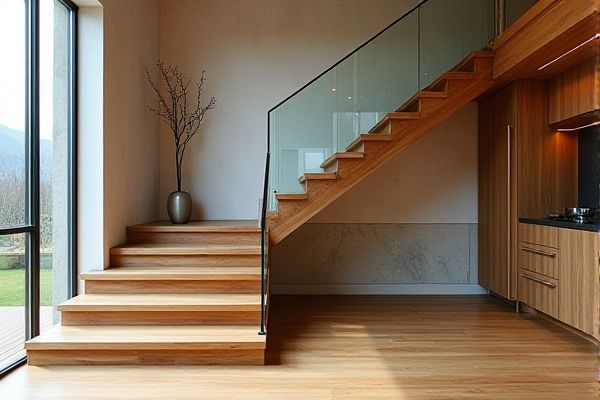
Glass-sided staircases offer a modern, sleek aesthetic that enhances natural light and creates a sense of openness, while wood-sided staircases provide a warm, traditional appeal with customizable finishes that complement various interior styles. Discover which option best suits Your home's design and functionality needs by exploring the detailed comparison in this article.
Table of Comparison
| Feature | Glass-Sided Staircase | Wood-Sided Staircase |
|---|---|---|
| Material | Tempered glass panels | Solid wood panels or planks |
| Appearance | Modern, sleek, transparent | Traditional, warm, natural |
| Durability | High resistance to scratches & weather | Can wear over time; susceptible to scratches and moisture |
| Maintenance | Requires regular cleaning to avoid fingerprints | Needs periodic polishing and sealing |
| Safety | Tempered glass is strong but can shatter under impact | Solid wood is sturdy and impact resistant |
| Cost | Generally higher installation and material costs | More affordable, depending on wood quality |
| Light Flow | Allows natural light to pass, brightens space | Blocks light, creates a cozier environment |
| Installation | Requires expert fitting and precision | Relatively easier and quicker to install |
Introduction to Glass-Sided vs Wood-Sided Staircases
Glass-sided staircases offer a modern, sleek appearance that enhances natural light and creates an open, airy feel in your space. Wood-sided staircases provide a classic, warm aesthetic with durable materials that can be customized through stains and finishes to suit various interior styles. Choosing between glass and wood sides depends on your design preferences, desired ambiance, and maintenance considerations.
Aesthetic Appeal: Modern Transparency vs Classic Warmth
A glass-sided staircase offers a sleek, modern transparency that enhances natural light and creates an open, airy ambiance, making spaces appear larger and more contemporary. In contrast, a wood-sided staircase provides classic warmth with rich textures and tones that add a cozy, timeless elegance to your home. Choosing between the two depends on whether you prefer a minimalist, luminous design or a traditional, inviting atmosphere.
Safety and Durability Considerations
Glass-sided staircases offer enhanced visibility and modern aesthetics but require tempered or laminated safety glass to prevent shattering and ensure durability. Wood-sided staircases provide sturdy support and can withstand heavy use, though they may need regular maintenance to avoid wear, warping, or splintering over time. Your choice should balance the sleek, easy-to-clean qualities of glass with the proven resilience and repairability of wood for optimal safety and long-term durability.
Light Flow and Spatial Perception
Glass-sided staircases enhance light flow by allowing natural and artificial light to pass through uninterrupted, creating a brighter and more open atmosphere in any space. They improve spatial perception by offering clear sightlines, making areas feel larger and less confined compared to wood-sided staircases, which tend to block light and visually segment the space. The transparency of glass maximizes visual connectivity, promoting a modern aesthetic and airy ambiance conducive to both residential and commercial environments.
Maintenance and Cleaning Requirements
Glass-sided staircases require frequent cleaning to remove fingerprints, smudges, and dust, often using glass cleaner and soft cloths to maintain their transparent shine. Wood-sided staircases demand regular dusting and polishing to prevent surface scratches and maintain the wood's natural luster, with occasional treatments for protection against moisture and wear. Both materials benefit from routine upkeep, but glass surfaces tend to reveal dirt more readily, necessitating more consistent cleaning efforts.
Cost Comparison: Upfront and Long-Term
Glass-sided staircases generally have higher upfront costs due to the price of tempered or laminated glass panels and specialized installation, often ranging from $3,000 to $6,000 for a standard staircase. Wood-sided staircases tend to be more cost-effective initially, with prices typically between $1,500 and $3,500, depending on the type of wood used, such as oak or poplar. Over the long term, glass requires less maintenance and resists wear, potentially lowering lifetime costs, while wood may incur additional expenses for refinishing, repairs, or replacement due to scratches and moisture damage.
Installation Process and Complexity
Glass-sided staircases require precise installation with specialized tools and expertise to handle fragile glass panels and secure fittings, often demanding professional craftsmanship for safety and durability. Wood-sided staircases offer more flexibility in installation, allowing for easier adjustments and repairs due to wood's malleability and availability of standard hardware. Your choice affects installation time and complexity, with glass requiring meticulous care while wood provides a more straightforward construction process.
Customization and Design Flexibility
Glass-sided staircases offer superior customization and design flexibility by allowing for sleek, modern aesthetics and the ability to incorporate various glass tints, textures, and frameless designs that enhance natural light flow. Wood-sided staircases provide a rich range of finishes, stains, and wood types, enabling traditional, rustic, or contemporary styles with intricate carvings and moldings tailored to complement architectural details. Both materials accommodate bespoke dimensions, handrail styles, and baluster designs, but glass maximizes openness while wood emphasizes warmth and craftsmanship.
Sustainability and Environmental Impact
Glass-sided staircases offer high sustainability due to their recyclability and long lifespan, reducing waste in construction. Wood-sided staircases, when sourced from certified sustainable forests, provide renewable material benefits but may involve higher carbon emissions during processing. Both options require careful consideration of lifecycle impacts, with glass promoting durability and wood supporting natural resource regeneration.
Choosing the Right Staircase for Your Space
Glass-sided staircases create a modern, open atmosphere by maximizing light flow and visually expanding your space, making them ideal for contemporary interiors or smaller rooms. Wood-sided staircases offer warmth, durability, and classic appeal, complementing traditional or rustic designs while providing sturdiness and privacy. Your choice depends on balancing aesthetic goals, maintenance preferences, and the architectural style of your home.
 homyna.com
homyna.com